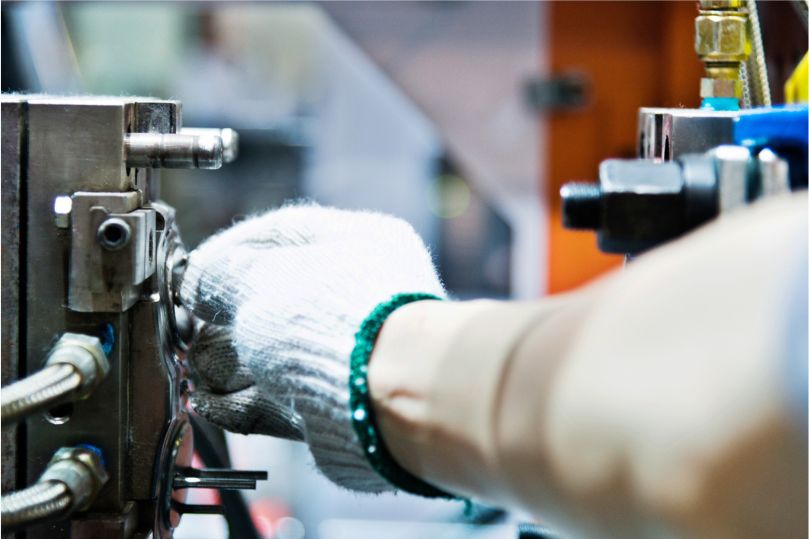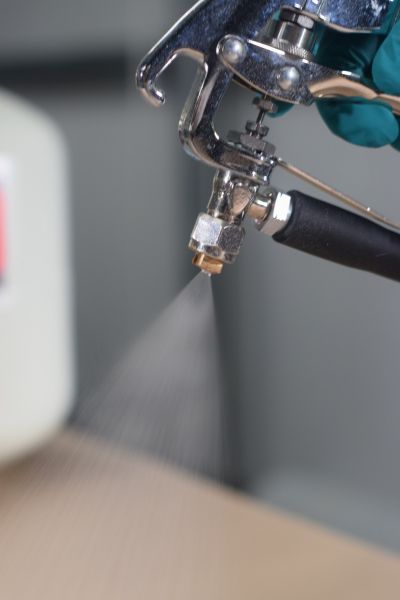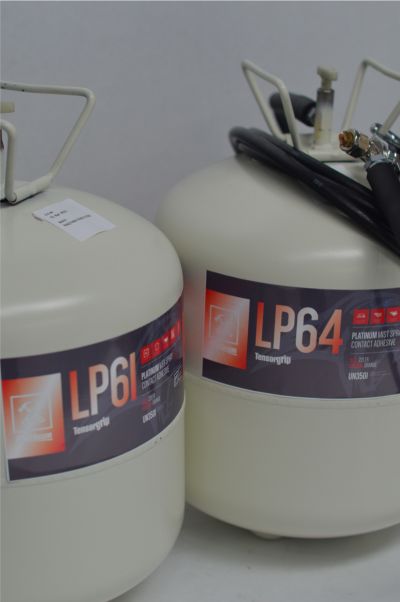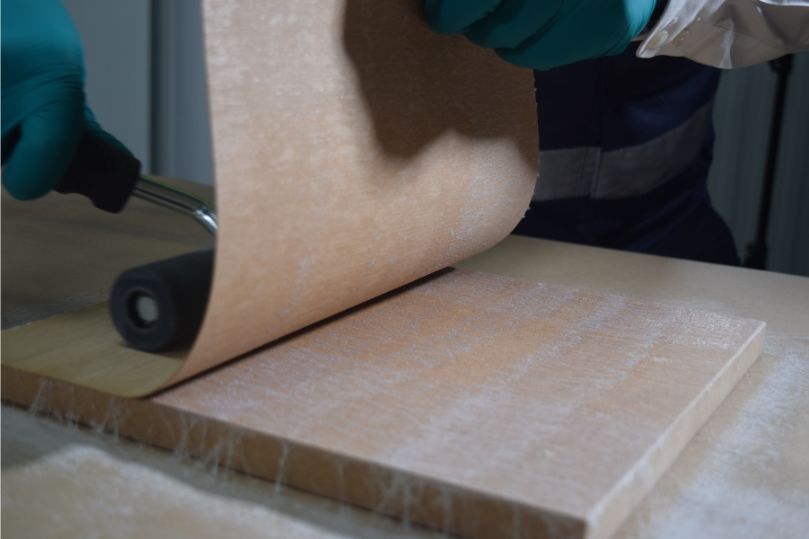Innovations in joinery manufacturing means that the industry is becoming increasingly competitive. Technology such as automation, robotics, AI and joinery adhesives are making it possible to produce more, higher quality and more specialised work than ever before.
In order to stay at the cutting edge, manufacturers need to make sure their workflows are as streamlined as they can be, and that their outputs are of the highest possible quality. Achieving both simultaneously is a challenge that depends heavily on selecting the right joinery adhesive for the right task.
In joinery manufacturing, there are some core tasks that require the use of adhesives. In this blog, we’ll take a look at each of them, exploring the requirements, the challenges and the best adhesives to choose for the job.

First of all, what is joinery manufacturing?
When we refer to joinery manufacturing, we’re talking about the fabrication of commercial furniture for use in a wide variety of high traffic environments including schools and colleges, libraries, offices, medical and veterinary centres, airports, hospitality venues and retail spaces.
Pieces being manufactured are typically required to offer some combination of storage, display and/or seating. Joinery manufacturers often produce bespoke work designed specifically for a particular client or project, but they might also manufacture specific products for a brand that then sells them into one of the above environments.
Joinery manufacturers are typically not involved in manufacturing doors, windows and stairs, fine furniture, or mass produced domestic furniture.
Why is adhesive used in joinery manufacturing?
In joinery manufacturing, adhesives are typically used in one of two ways – either to supplement or replace mechanical fixings during product construction, or for the application of decorative finishes such as laminates and veneers. Here’s a quick look at some of the main tasks joiners will typically complete using adhesives:
1. Wood buildups: Joining multiple layers of a base material like MDF or plywood together to create the required thickness and load-bearing capacity for a finished piece of furniture.
2. Solid surface: Fixing solid surface materials such as Corian and Getacore to a timber structure such as a desk or counter.
3. Laminating: Applying decorative sheet materials such as high-pressure laminate (HPL), metal sheets, faux leather, vinyl or even textiles to the surface of a timber structure.
4. Wood veneers: Applying paper-backed real wood veneers to an MDF or plywood base structure for the appearance of solid timber, with none of the design constraints.
Adhesives can add strength to wood buildups and reduce the number of mechanical fixings required for cost or time-saving reasons. For lamination, adhesives are essential for creating a seamless look without the need for any other fixings.

How can spray adhesives streamline joinery manufacturing?
Choosing the right joinery adhesive isn’t just about formulation – it’s also about process. Switching from manually-applied adhesives to spray joinery adhesives like Tensor has significant productivity, safety and occupational health benefits that can help workshops increase outputs without investing in new machinery or extra manpower. Learn more about the ways Tensor adhesives can streamline joinery manufacturing processes here.

What types of adhesives are best for joinery manufacturing?
The type of adhesive required for a joinery manufacturing task will depend on the task itself, and the materials being used. Different adhesive types can deliver different bonding properties, and a different glue line that is adapted to each task.
Timber to timber adhesives
For joining thick materials, where multiple layers of MDF or plywood are being stuck together to create a stronger structure, you need instant grab, high bond strength and a thicker glue line to accommodate any flexion in the surfaces being joined.
Instant grab means that the two surfaces will adhere as soon as they are brought together without slipping and sliding around – this makes it easier to bond large sheets together, and reduces the need for clamping.
High bond strength means what you might expect – the cured join is extremely strong with a high degree of sheer resistance. This is important because commercial furniture often has to cope with significant loads due to storage or seating requirements.
A thicker glue line helps to deliver bond strength by distributing loads more evenly across the surface of the join.
Recommended products: L12, L90 (DCM-free), L20 (DCM-free)
Solid surface adhesives
For solid surface joins, the same principles that govern wood buildups apply – you need a high grab, high-strength adhesive with a thicker glue line that ensures long-lasting, robust performance.
While solid surface materials are dimensionally stable, the timber underneath will expand and contract according to atmospheric moisture and temperature. Therefore the adhesive acts as a filler or buffer between the two surfaces that allows for a certain degree of flexibility in the finished piece.
Many solid surfaces are composites of acrylic resin mixed with minerals, acrylic or stone chips, and pigments. Since many of the solvents typically used in joinery adhesives can damage acrylic surfaces, it’s important to choose a compatible product. Several of Tensor’s joinery adhesives are endorsed or officially approved by the leading solid surface manufacturers, including Westag.
Recommended products: L90, L42

Laminating adhesives
Bonding thin laminates is a completely different process to bonding thick wood buildups. Laminates are light, so they don’t require the same bond strength, and they require a thin glue line that will allow them to cure perfectly flat and smooth.
Spray pattern is important when bonding laminates – especially high gloss materials. This is because they are prone to ‘telegraphing’, where the underlying pattern of the adhesive shows through the laminate, giving the finished piece a rippled or bumpy appearance. For high gloss laminates in particular, a fine mist spray is recommended.
If the laminate in question is vinyl based, you’ll need to select an adhesive that’s resistant to plasticiser migration – otherwise you risk bond failure over time.
Bonding laminates may also require you to select a heat-resistant adhesive. This might be because the finished piece could be exposed to heat – for example, from direct sunlight, ovens or industrial machinery – or because the piece will be used in a building with strict regulations around fire safety, such as an airport.
Recommended products: L17, L19, L31, L71, LP64, LP61
Veneer adhesives
If you routinely apply real wood veneers, you’re probably accustomed to using PVA adhesives. Spray joinery adhesives can significantly speed up this process by delivering rapid bonds that don’t need to be pressed while they cure. However, care needs to be taken when using solvent-based adhesives for applying veneers – and they are only suitable for use with backed veneer products. For a complete guide to the best products and processes, check out our blog on real wood veneers.
Recommended products: L24, L31, LP64
Want to find out more?
If you’re considering a switch to spray adhesives, or you want to learn more about alternative products that could improve your joinery manufacturing processes and outputs, get in touch with our expert customer service team – we’ll be happy to offer advice, and also help you to locate your nearest Tensor Joinery distributor!